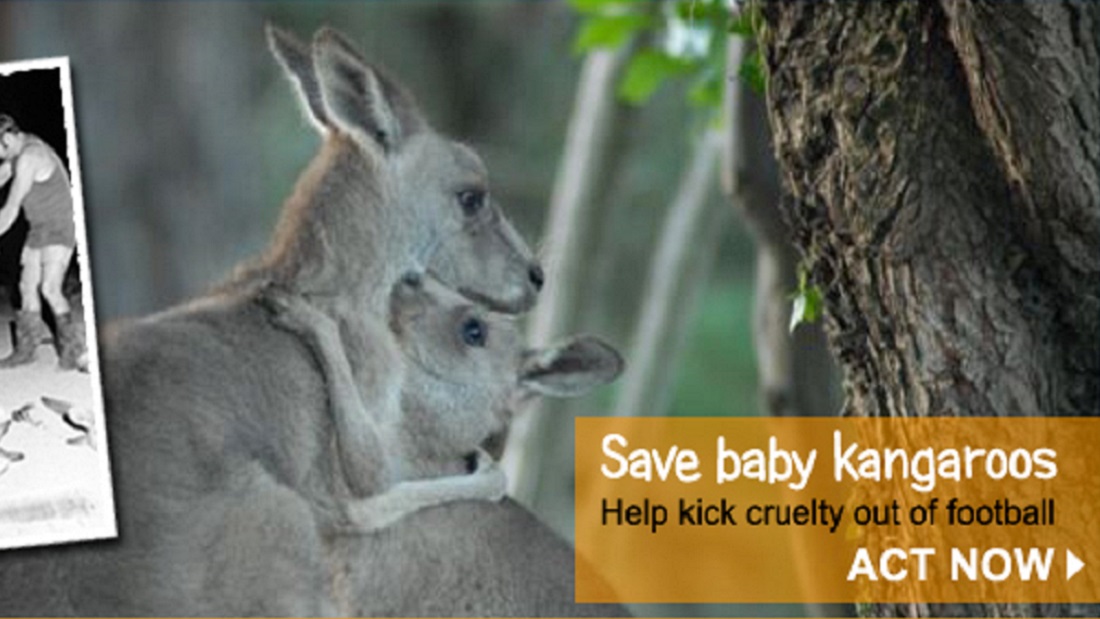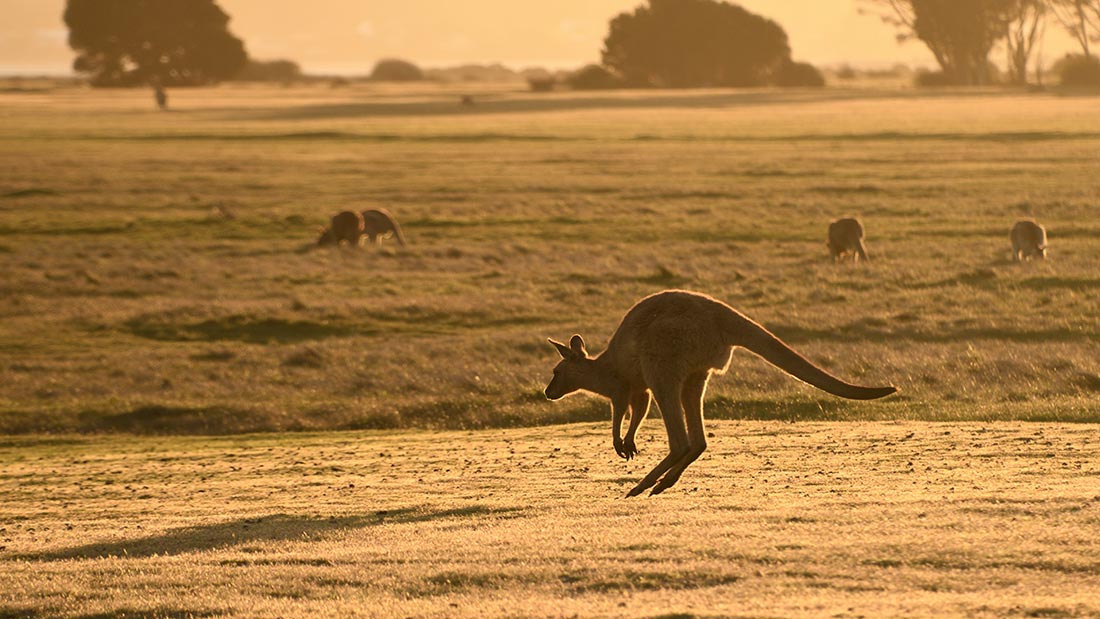Adidas Kangaroo Leather Campaign

In 2003, Viva!USA filed a lawsuit against Adidas America Inc and three sports shops for illegally selling kangaroo skin Predator boots in California.
California has often been a leader in progressive legislation and in the 1970s passed a law to protect kangaroos, crocodiles and alligators by prohibiting the import and sale of products made from their body parts. It was a commendable attempt to protect wildlife from commercial exploitation and keep it where it belongs – in the wild. In what appears to be a direct flouting of this penal code, Adidas has been selling its kangaroo skin Predator boots in sports shops around the state.
Having discovered this potential law breaking, Viva!USA found attorneys willing to take on the case pro bono and the lawsuit was filed. Reuters, Associated Press and all major wire services sent the news around the world and international media immediately picked up on it. The day the lawsuit was filed – Adidas’ share price dropped!
In what seems more than coincidence, California state senator Dennis Hollingsworth introduced a bill into the state legislature to repeal that same penal code on which our action is based, but it was eventually quashed. 2004 saw two bills introduced, but both were unsuccessful due to lobbying by Viva!USA.
In 2005, despite the overwhelming evidence supplied by Viva!USA to show that it was vital to keep the ban in place, Assembly woman Nicole Parra (Representing Fresno, Kern, Kings, and Tulare Counties – and supported by Adidas) introduced the bill AB734 to overturn it. Once again Senators listened to reason, and it was stopped in the Senate Natural Resources Committee.
However, in November 2005 the First District Court of Appeal ruled that California’s ban on importing shoes and other items made from the hides of Australian kangaroos cannot be enforced as federal law takes precedence, despite California state law clearly banning such sales.
Viva! Attorney Orly Degani announced the group is considering an appeal to the California Supreme Court, saying “We’re talking about a very cruel practice that the California Legislature does not want to condone.”
Viva! will continue to lead the boycott of Adidas, and will do so until they finally face facts and cease killing for kicks.

Adidas says: “Kangaroo leather is used by all sorts of manufacturers globally to make a wide range of products…”
Fact: This year alone, hunters are licensed to kill 3.8 million adult kangaroos to supply the kangaroo industries in what is the largest massacre of land animals on the planet. An email recently sent out by John Kelly, spokesperson for the Kangaroo Industry Association of Australia, states: “This [soccer boot] industry is vital to the kangaroo industry. Without it underpinning kangaroo skin prices the entire industry would be at risk”. With 70 per cent of the market for professional football boots, Adidas is the kangaroo industry’s largest customer – and therefore a driving force behind the massacre.
Adidas says: “Like the group Viva!, Adidas is opposed to kangaroos being killed in an inhumane or cruel manner.”
Fact: It is a simple fact that when millions of kangaroos are being shot, instances of cruelty and inhumane killing are unavoidable.
The Australian Government, the kangaroo industry and Adidas all allege that kangaroos are shot “humanely” – their definition of this being a single shot to the brain. However, even the Code of Practice for the Humane Shooting of Kangaroos (the guideline document which hunt<p>ers are supposed to follow) states: “No matter how carefully the shooter aims, some kangaroos will not be killed outright”. The industry also claims to be self-regulating with regards to humane/inhumane killing, in so much as processing plants will reject the carcasses of kangaroos who have been shot in the body, not the head, thereby encouraging shooters to aim accurately and kill ‘humanely’. However, a report carried out by the Australian RSPCA found that approximately 100,000 kangaroos per year are not killed humanely, and even this is a conservative estimate as the figure is only based on carcasses arriving at processing plants where their skins are examined for bullet holes, no monitoring is actually done in the field. The RSPCA’s estimate does not take into account kangaroos who are shot in the body and whose bodies are left behind because they would be rejected at the processing plant, nor kangaroos who are only injured and left to die in the outback, of whom the RSPCA report also states: “Accurate figures on injury rates during shooting are extremely difficult to obtain”.
Furthermore, perhaps the most upsetting acts of cruelty involve baby joeys – the ‘worthless’ byproducts of the kangaroo slaughter. A mother kangaroo will often have one joey in the pouch and another “at-foot”. The Code of Practice recommends pouch joeys be killed either by decapitation with a sharp object or a heavy blow to the brain, but hunters have previously admitted to using joeys as footballs, hitting them with crowbars, smashing them against cars or simply leaving them on the ground to die. Viva! has video footage of one hunter dragging a joey from the pouch and stamping on his/her head. At-foot joeys, according to the Code, may also be shot, those who aren’t are left to hop off into the night and without their mothers to protect and feed them, will invariably die of starvation, predation, cold or neglect. The RSPCA report questions both the use of decapitation as a humane method of killing joeys, and also states “in general, the use of a heavy blow to the head is not considered a humane method of euthanasia for most species” and concludes that “the only solution which would avoid the potential of cruelty to pouch young would be to avoid shooting females altogether.”
Adidas says: “This is why we insist that our suppliers fully comply with the Australian Government’s strict rules on kangaroo culling. These rules require those involved in culling to obtain a licence or permit to operate from the Government. These licensed operators must comply with a stringent code of practice which controls how they operate.”
Fact: Unfortunately, the Australian government actively supports and promotes the kangaroo massacre because of the revenue it generates. Kangaroos do not need to be culled in the first place, they are an integral part of Australia’s fragile environment and should be valued as unique, sentient beings.
The “Code of Practice” – the ‘strict rules’ Adidas is referring to – is a guideline document, not a law and in order to obtain a licence, all hunters have to do is to read it, understand it, and pass a one day marksmanship course – although in Western Australia, the shooting test isn’t even compulsory.
Monitoring the industry is extremely difficult as the hunting takes place in the dead of night, miles away from civilisation and very few rangers are employed by the states to oversee the killing. For example in Queensland, the state with the highest level of commercial kangaroo killing -1,378,505 kangaroos killed commercially in 2000 – there were only six Queensland Parks and Wildlife Service staff with responsibility for monitoring the kangaroo harvest and overseeing the regulation of the industry! Quotes from the RSPCA report confirm that the monitoring of the industry is not exactly stringent: “From the discussions carried out during this survey, it appeared that law enforcement resources within State wildlife agencies had decreased since 1985, and several processors remarked about the lack of inspections and any follow up reports” and that “one processor pointed out that he had sent a tag from a body-shot kangaroo to the appropriate wildlife agency but had not heard of any result from this action.” The fact that even kangaroo processors themselves criticise the lack of inspections, follow up reports and actions taken against those not complying with the Code makes Adidas’s claims flimsy to say the least!
Adidas says: “if our suppliers fail to comply with the law they will be refused an export permit for the leather by the Australian Government.”
Fact: There are no laws protecting kangaroos from cruelty. What laws are in place relate to trade management, tagging the bodies of dead kangaroos and the export of the processed skins – not to animal welfare. In Western Australia, for example, there have been only a few prosecutions involving the kangaroo industry – two for supplying untagged carcasses to processors and two for processors accepting them.
The assurances given in the fact sheet by Environment Australia are almost identical to those given by numerous other governments in defence of slaughtering whales, tigers, elephants, rhinos and a host of other animals who are now, or have been, on the endangered list. They have all proved meaningless and these creatures have been driven to the brink of extinction by rampant exploitation, supported by governments and their numerous ‘independent’ bodies. Fish are a classic example – the most studied, monitored, scientifically assessed and managed animals on earth. The result has been a catastrophe, resulting in the collapse of fish populations world wide.
Australia’s exploitation of kangaroos is no different and the quotas are set solely to meet commercial demand. Scientifically it is unjustifiable, which is why the industry and government refuse to discuss the latest studies and decline even to acknowledge their existence. Morally, it is abhorrent, which is why they also dismiss the cruelty and refuse to address the killing and abandonment of baby joeys, pretending instead that the killing is strictly controlled. There is almost no-one monitoring the killing in the outback as it happens and no laws have been introduced specifically to control shooters.
Australia has the worst record in the world for causing the extinction of wildlife – currently, in Australia alone there are 27 species listed as extinct, 33 as endangered, 51 as vulnerable, one as ‘conservation dependant’ and one as critically endangered.
Its environmental record is equally depressing, with vast tracts of the country turning to desert because of its insistence on grazing sheep and cattle – 160 million of them – on land which is entirely unsuited to these animals’ hard hooves. This developing catastrophe is well documented and beyond argument but still the government continues with policies of clear felling and encouragement of livestock farming. All its assurances and claims have to be seen in this light. Kangaroos, who have lived in harmony with the fragile environment for millions of years and are essential to its regeneration and ultimate survival, are the scapegoats.

In 2010 Wayne Rooney, John Terry and Frank Lampard came under fire (along with other major football stars) over the slaughter of baby kangaroos to make football boots. As a result of pressure from animal welfare groups, Viva! and the Australian Wildlife Protection Council, a Nike spokesperson confirmed that they would stop using the skins of kangaroos in their football boots by claiming the company was moving towards eradicating the use of kangaroo leather altogether.
But, we’re still waiting!
In 2012 Adidas promised to phase out the use of kangaroo leather by 98 per cent over the following 12 months, due to concerns over cruelty and pressure from animal lovers. It was a move that would without a doubt save the lives of countless kangaroos and their baby joeys.
In 2018 kangaroo leather football boots remain widely available in high-street stores.
Write to Manufacturers
Tell Adidas, Nike, Umbro and Puma! to ditch kangaroo leather once and for all!
Despite encouraging claims that football boot manufacturers are moving away from using kangaroo leather, all four of the main companies (Adidas, Nike, Umbro and Puma) still use it to some degree. Write to them (use our suggested letter/email below or write your own) to give them a polite shove towards a cruelty-free future, urging them to go 100 per cent synthetic.
Over a million baby kangaroos (joeys) die each year – and the sale of football boots made out of kangaroo leather helps drive this horrendous slaughter.
Thank you to everyone who has written so far and continues to keep up the pressure.
Make your voice heard!
Write or email this message to the companies listed below.
Suggested message:
“Dear [name of company]
I am writing to ask that you discontinue the use of kangaroo leather in your football boots. It is this trade which helps drive what is currently the biggest massacre of land animals on the planet.
Population estimates from 2017 put the numbers of kangaroos in Australia at just over 46.1 million; down by over 11 million from 2001 when there was an estimated 57.4 million. Worryingly a drop has been seen in all four species that are hunted. Yet still, over six million kangaroos are earmarked for slaughter each year. This figure takes no account of the hundreds of thousands of baby ‘Joeys’, who are either left to die from starvation or are removed from their dead mother’s pouches and clubbed to death with iron pipes.
An adult female kangaroo will usually have two youngsters with her: a baby kangaroo in pouch and an adolescent at foot. You say that you are reassured by the Australian Government’s guidelines for ‘humanely’ killing kangaroos. However, these same guidelines advocate pulling baby joeys from their dying mother’s pouches and smashing them around the head and/or decapitating them. The adolescents are meant to be shot, but many will escape the carnage and die of predation from other wild animals. For almost every female kangaroo killed to make your football boots, two other lives will be snuffed out. Around a million baby kangaroos die each year because of the trade in kangaroo parts. There can be no justification for this.
It is also impossible to truly assess the welfare of the adults that are shot, as this is invariably done at night in the Outback. Away from the glare of public scrutiny, millions are shot every year – and the Australian RSPCA has estimated that around 100,000 adults are not killed humanely and some may temporarily survive with horrific wounds, such as having their jaws shot off.
Just because there may be a demand for kangaroo leather does not make the trade in their skins morally acceptable. Especially when you already make excellent boots made from synthetic versions.
Please kick cruelty out of football once-and-for-all and commit to ending the use of kangaroo leather in all your football boots.
Until this happens, I will boycott your company and encourage and of my friends and family to do likewise.
Yours faithfully,
[Your name and address]”




